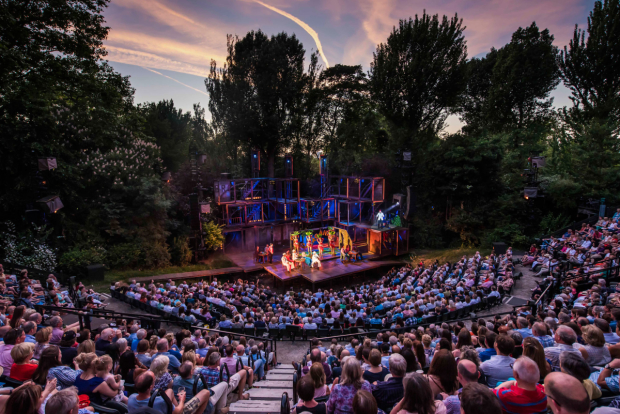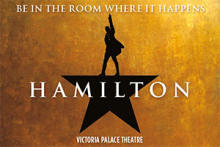Letting the outside world into a theatre can add to the drama
After football encroaches on a performance of ”Hamilton”, Matt Trueman reflects on how letting the outside in can affect a show

© David Jensen
A text message. A crisp packet. Croatia 2, England 1. After a member of the Hamilton audience brazenly announced the final score, mid-show, on Wednesday night, Obioma Ugoala, the West End's George Washington, took to Twitter to dissect the impact of the outburst. "In that moment," he wrote, "the outside world came crashing into the theatre." One shout punctured the performance like a pin in the road.
The incident got me thinking, not about audiences and etiquette, but about architecture – specifically what it means to bring the outside world crashing in.
Theatres are expressly designed to foster concentration. Whether they're ornate proscenium arches that point 2000-odd eyes in the same direction, or big black box studios stripped of all distractions, the aim is to induce a strange, trance-like state. Since performance is fragile and easily burst, the rooms that host it have to help out. The best forge a focus, holding us so that we might collectively hold our breath. It's one of the reasons I love the Barbican's doors so much. In swishing shut as a performance begins, they make a show of sealing us in.
Some shows choose to break that closed space, to prise open a theatre and let the world rush back in. As Cordelia Lynn's One For Sorrow reaches its climax, an argument spiralling out of control, tension rising so much that the air seems to stagnate, one of the characters throws open a window onto Sloane Square. It's a blessed release: the sound of traffic seeps in, a breeze cools things down. In a split second, you remember where you are – in a theatre, safe and sound – and return to yourself. Emotion dissipates. Reason's restored. It's as if a pressure valve's been released.
Little Revolution threw open the Almeida's doors to remind us that the riots it represented onstage happened for real
Used well, this is one of the most effective tools in the box. One For Sorrow's director James MacDonald deployed it before – and in the same space. At the end of Sarah Kane's 4.48 Psychosis, a window was opened and the room seemed to breathe; that play's constrictive spirit was almost set free. It served a reminder that, no matter how awful things get or how enclosed one might feel, the world carries on outside the room. Alecky Blythe's Little Revolution threw open the Almeida's doors to remind us that the riots it represented onstage happened for real, that the rifts they exposed were still in existence and that sitting in a theatre didn't absolve us of responsibility. The world carries on.
Outdoor theatres don't have the luxury of such control. They are, by definition, open to the world; no inside, no out. Planes fly overhead. Pigeons flutter by. The world cannot but make itself felt. That, inevitably and necessarily, changes the way we watch. Outdoors, theatre can't create the same intensity of concentration – and that's a great part of its pleasure. Your mind wonders, your thoughts idle, your eye takes in the surroundings, the sky, the crowd. It makes theatre feel that much more leisurely and it's only as night falls that shows start to grip. It's one of the joys of the art-form: as darkness deepens, it draws an audience in.
The world cannot but make itself felt in outdoor theatres
It does, however, mean a staging needs to do more to cut through. If Timothy Sheader has transformed Regent's Park, it's partly because he's encouraged designers to cut loose. Stages, there, are sculptures: shipping crates stacked high, wrecked planes jutting out of the ground, giant mirrors over grassy lawns. Like the opera at Bregenz in Austria, where extraordinary platforms paddle in a lake, the stage makes a statement.
In Avignon, where I've spent the last week, the festival's main stage is the Cour d'Honneur – a high-walled, open-air courtyard in the Palais du Papes. This year, a huge fallen statue dominates its vast stage: a stone head on its side, a spider-like hand that seems to have sprung to life. Thomas Jolly's Thyestes starts just as night falls and plays through until midnight. It's a rare outdoor staging that dares to dabble in darkness: lit in an eerie, silvery half-light with individual actors pinned in place by tight spots. Sometimes searchlights burst through the floor, sometimes laser beams slice through the air. At one point, a swarm of black crepe paper moths bursts out of a window like a living cloud, then flutter in the winds that whip around those high walls.
Everything on that stage is going for broke, almost as a stadium pop concert does. No matter the stars twinkling overhead, no matter the whistles of wind or the cold, this was a momentous staging making its presence felt, forcing the sort of concentration you ordinarily find indoors. Russia and Croatia were deep into extra time, but even the football couldn't find a way through.



















